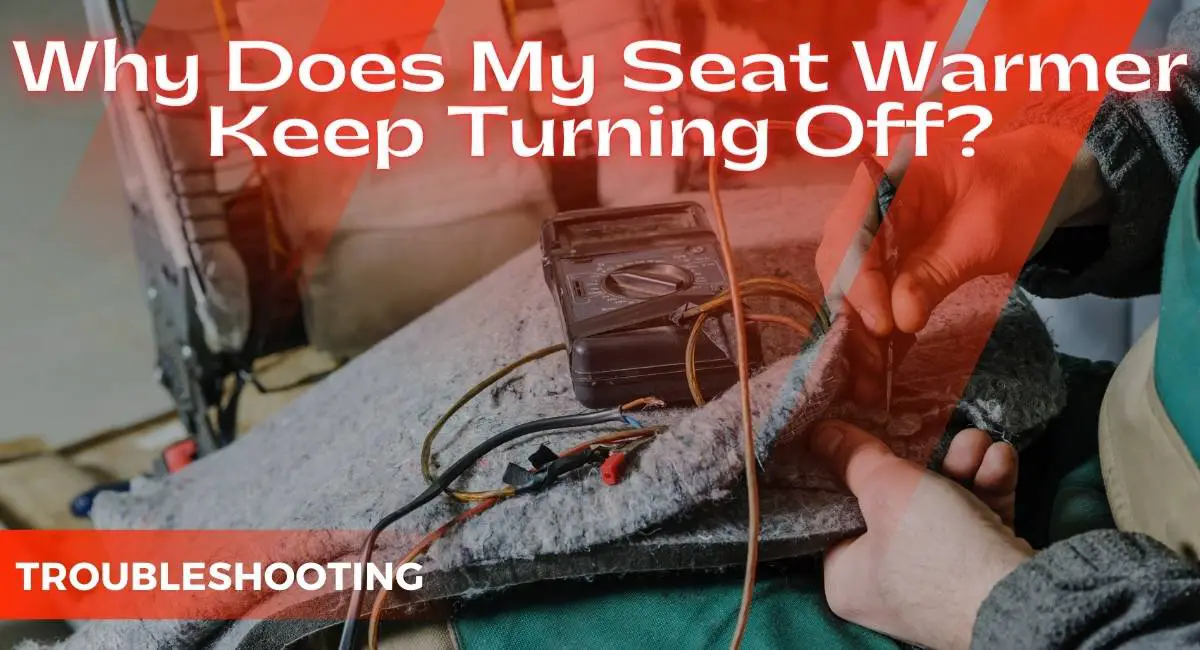In the cold winter months, few things are as comforting as stepping into a warm vehicle, and for many, seat warmers have become an essential feature for enhancing driving comfort. However, what happens when your beloved seat warmer keeps turning off unexpectedly?
Your seat warmer may turn off for various reasons, such as electrical issues like blown fuses or faulty wiring, overheating protection mechanisms like temperature sensors or thermal cutoff switches, or even user error, such as accidental deactivation or a malfunctioning control switch.
This issue can be frustrating, but here, you’ll get to understand the underlying causes and implementing practical troubleshooting steps can help resolve the problem and restore your cosy driving experience.
Understanding Seat Warmer Functionality
Before we get deep into seat warmer issues, let’s understand how these seats function. Car seat warmers, also known as heated seats, are commonly found in modern vehicles designed to provide warmth and comfort to occupants during cold weather conditions. They typically consist of heating elements embedded within the seat cushion and backrest, which generate heat when an electrical current passes through them.
Car seat warmers are controlled by switches or buttons on the vehicle’s dashboard or side panels, allowing drivers and passengers to adjust the level of warmth according to their preferences. This feature enhances driving comfort, especially during chilly winter drives, by keeping occupants cosy and reducing the need to rely solely on the vehicle’s heating system.
The popularity of seat warmers has soared in recent years. Several factors propel this growth, including the expanding trend of vehicle electrification, heightened consumer demand for comfort and luxury amenities in automobiles, and continual advancements in seat heating technologies.
In 2019, the seat warmer market was valued at around USD billion, with projections indicating a growth to USD billion by 2025, reflecting an annual growth rate of about 7% during the forecast period.

Common Causes of Seat Warmer Turning Off
The frustration of having your seat warmer abruptly turned off can disrupt a blissful experience on a chilly day. Several factors can contribute to your seat warmer shutting off prematurely:
1. Electrical Issues
Electrical issues can disrupt the normal functioning of seat warmers, leading to discomfort for occupants and potentially compromising the safety and reliability of the vehicle’s electrical system.
The following are some ways electrical issues affect the seat warmers:
Blown Fuse
A blown fuse in the seat warmer circuit can interfere with the flow of electricity, causing the system to shut down. While fuses have a design that protects electrical circuits from damage due to overloads or short circuits, if a fuse blows, it indicates an underlying issue that needs to be addressed.
Wiring Problems
Faulty wiring or loose connections can interrupt the electrical circuit, leading to the seat warmer turning off unexpectedly. Over long periods, the car seat wires can become worn or damaged, especially in older cars or those exposed to harsh environmental conditions.
Faulty Connections
Poor connections between the heating elements and the electrical system can result in intermittent operation or complete shutdowns. Corrosion, rust, or loose terminals can compromise the conductivity of the electrical connections, leading to issues with the seat warmer.
2. Overheating Protection
Overheating protection mechanisms are integral safety features in seat warmers designed to prevent excessive heat buildup that could lead to discomfort, damage, or even safety hazards.
However, these protections can sometimes cause issues with the seat warmer if they activate unnecessarily or malfunction. Here’s how overheating protection mechanisms can lead to problems:
Temperature Sensors
Seat warmers have temperature sensors that monitor the heat level. The system may shut off to prevent overheating if the temperature exceeds a certain threshold. This safety feature helps protect the seat warmer components and prevents potential fire hazards.
Thermal Cutoff Switches
In addition to temperature sensors, thermal cutoff switches serve as a safety mechanism to deactivate the seat warmer if it reaches excessively high temperatures, reducing the risk of fire or damage. These switches are typically located within the seat warmer circuit and have a design that interrupts the flow of electricity when triggered by high temperatures.
But what happens when a seat warmer overheats? Using a seat warmer when overheating can be risky and potentially dangerous. Here’s why:
- If your seat warmer overheats, it can cause burns to your skin or clothing. Some users have reported burning smells, visible smoke, and even fires from their seat warmers.
- Safety experts recommend setting a temperature limit for seat heaters. Ideally, the most conservative approach is to keep the heater temperature below 105 degrees Fahrenheit. It is especially crucial for individuals with reduced sensation in their lower limbs, such as those with paralysis.
- If you suspect your seat warmer is overheating, turn it off immediately. Continuing to use it could exacerbate the issue and pose a safety risk.
3. User Error
User error can contribute to issues with the seat warmer in several ways:
Accidental Deactivation
Users may inadvertently turn off the seat warmer, mistaking the controls for other functions. It is a common issue, especially for drivers unfamiliar with the layout of the vehicle’s controls or who accidentally press the wrong buttons.
Malfunctioning Control Switch
A defective control switch can disrupt the operation of the seat warmer, causing it to turn off unexpectedly. Control switches can wear out over time due to frequent use, exposure to moisture, or mechanical failures.
What are the Troubleshooting Steps?
Now that you know the issues affecting this unique innovation—your car seat warmer, it’s time to identify and resolve them. Follow these troubleshooting steps:
- Checking the Fuse: Inspect the fuse associated with the seat warmer circuit to determine if it’s blown. The only solution to a blown fuse is replacing it with one of the correct ratings. Consult your vehicle’s owner’s manual or fuse box diagram to locate the fuse for the seat warmer circuit.
- Inspecting Wiring and Connections: Inspect the wiring harness and connections thoroughly for indications of damage, corrosion, or looseness. You need to repair or replace any faulty components as required. Use a multimeter to test the continuity of the wiring and ensure proper electrical conductivity.
- Testing Temperature Sensors and Cutoff Switches: Use a multimeter to test the functionality of temperature sensors and thermal cutoff switches. Replace any defective sensors or switches. Follow the manufacturer’s instructions for testing these components and refer to the vehicle’s service manual for specific troubleshooting procedures.
- Verifying Control Switch Functionality: Test the control switch for proper operation. If the switch is malfunctioning, replace it with a new one. Look for indications of wear or damage on the control switch, such as cracked buttons, insecure connections, or signs of corrosion.
- Conducting User Error Checks: Educate users on the correct operation of the seat warmer controls to minimise the risk of accidental deactivation. Ensure that control switches are easily accessible and clearly labelled. Provide instructions or visual aids to help users understand how to use the seat warmer effectively.
Solutions and Fixes
Based on the results of your troubleshooting efforts above, implement the following solutions to address the issue:
1. Replacing Blown Fuses
Install new fuses of the appropriate rating to restore electrical continuity in the seat warmer circuit. Use a fuse puller or needle-nose pliers to remove the old fuse securely and insert the new one.
2. Repairing or Replacing Faulty Wiring
Repair or replace damaged wiring with new wiring to ensure proper electrical connectivity. Use wire strippers, crimp connectors, and electrical tape to repair damaged wires. Replace any corroded or frayed cables with new ones to prevent further issues.
3. Repairing or Replacing Malfunctioning Components
Replace defective temperature sensors, thermal cutoff switches, or control switches to restore the functionality of the seat warmer. Follow the manufacturer’s instructions for replacing these components and use genuine OEM parts for optimal performance.
4. Educating Users
Instructing users on properly operating the seat warmer controls is critical to minimise the risk of accidental deactivation. Demonstrate how to use the controls correctly and emphasise the importance of following the manufacturer’s recommendations for safe usage.
5. Preventive Measures
To prevent future issues with your seat warmer, consider implementing the following preventive measures:
- Regular Maintenance Checks: Schedule routine inspections of the seat warmer system to detect and address any potential problems early on. Inspect the wiring, connections, and components for any indications of wear or damage and undertake any essential repairs or replacements.
- Avoiding Overuse: Use the seat warmer sparingly and avoid prolonged periods of continuous operation to prevent overheating and potential damage to the system. Follow the manufacturer’s recommendations for safe usage and avoid using the seat warmer at the highest heat setting for extended periods.
- Proper Handling of Control Switches: Handle the control switches carefully to prevent damage or malfunction. Avoid excessive force when operating the switches, and use caution when cleaning or servicing the controls to avoid moisture or debris buildup.
Conclusion
A malfunctioning seat warmer can diminish your driving comfort, but understanding common causes and implementing effective troubleshooting can swiftly address the issue. Regular maintenance and appropriate usage are crucial for sustaining your seat warmer’s longevity and ensuring consistent warmth and comfort on cold winter drives.
Following the steps outlined in this guide and implementing preventive measures, you can keep your seat warmer functioning correctly and enjoy its cosy warmth for many miles. Consider your vehicle’s owner’s manual and seek professional assistance to ensure safe and effective troubleshooting of seat warmer issues.
